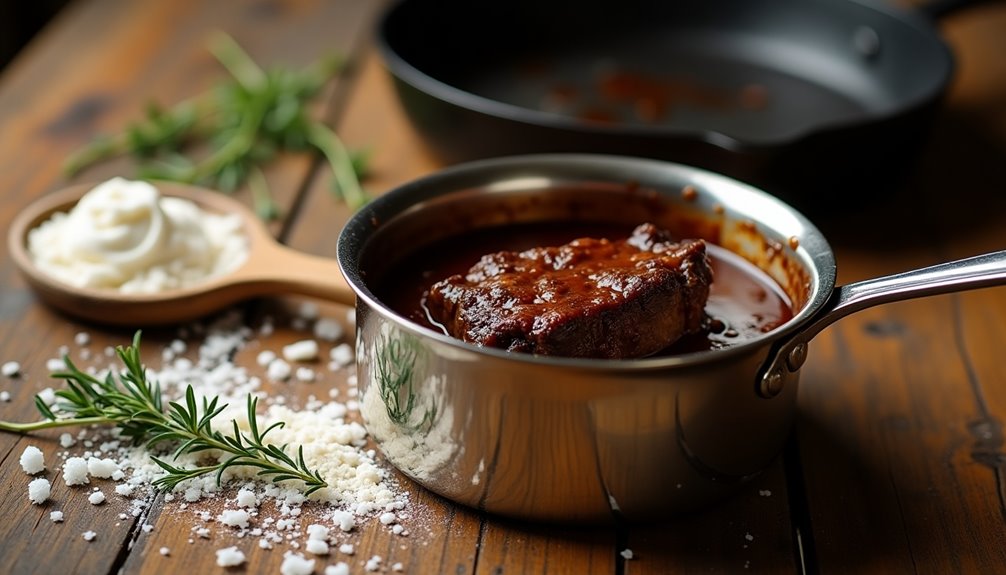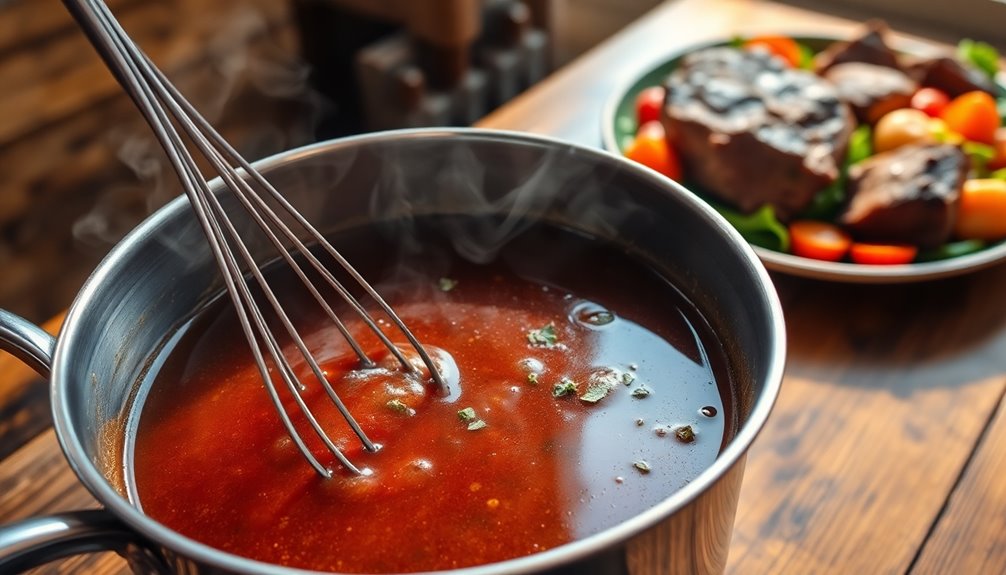To make gravy from pot roast juice, strain the drippings for a smooth base. Choose a thickening agent like flour or cornstarch and whisk it into the drippings over medium heat. Bring the mixture to a gentle boil, stirring constantly until it thickens. Season with salt, pepper, and a splash of Worcestershire sauce for extra flavor. Let it simmer briefly, and then serve warm over your sliced pot roast. There's more to explore about enhancing your meal!
Key Takeaways
- Strain the pot roast drippings through a fine mesh sieve to eliminate solids for a smooth gravy base.
- Whisk ¼ cup of all-purpose flour or a cornstarch slurry into the drippings over medium heat to thicken.
- Heat the mixture to a gentle boil and stir continuously until desired consistency is achieved, about 5 to 10 minutes.
- Season the gravy with salt, pepper, Worcestershire sauce, and optional sautéed onions for enhanced flavor.
- Serve the warm gravy over sliced pot roast and pair it with mashed potatoes for a complete meal.

Making gravy from pot roast juice is a simple way to elevate your meal, especially when you want to savor every drop of that rich flavor. There's something undeniably comforting about a well-made gravy that can transform your pot roast and mashed potatoes into a hearty feast. Let's dive into the steps to create this delicious addition to your meal.
Start by gathering the pot roast drippings left in your roasting pan. After you've removed the pot roast, you'll want to strain those drippings through a fine mesh sieve. This step ensures that you eliminate any solids, giving you a smooth, velvety base for your gravy. If you skip this part, your gravy might end up lumpy, which isn't the texture you're aiming for.
Once you have your strained drippings, it's time to choose a thickening agent. You have a couple of options here. If you prefer a classic approach, use about ¼ cup of all-purpose flour. Simply whisk the flour into the drippings over medium heat, ensuring there are no clumps.
Alternatively, you can create a cornstarch slurry by mixing 2½ tablespoons of cornstarch with an equal amount of water. This method can yield a lighter texture, and it's a good option if you're looking for a gluten-free alternative. Regardless of which thickening agent you choose, keep stirring the mixture continuously to prevent any burning.
As you heat the mixture, bring it to a gentle boil. This should take around 5 to 10 minutes, during which you'll notice the gravy thickening to your desired consistency. If it seems too thick, you can always whisk in a bit of water or more drippings.
Once your gravy reaches that perfect texture, it's time to season it. Sprinkle in some salt and pepper to taste, but don't stop there. For a touch of umami, add a splash of Worcestershire sauce. You might also consider incorporating sautéed onions for an extra layer of flavor. Just remember to taste as you go; the goal is to create a gravy that complements your pot roast beautifully.
After you've seasoned the gravy to your liking, let it simmer for a few more minutes to meld those flavors together. The aroma will fill your kitchen, and you'll know you're on the right track.
Finally, serve the warm gravy generously over your sliced pot roast and a heap of mashed potatoes. This rich, flavorful gravy won't only enhance the dish but also ensure that you're savoring every bite.
In just a few simple steps, you've transformed your pot roast drippings into a luscious gravy that takes your meal to the next level. Enjoy the satisfaction of creating something special that everyone will love!
Frequently Asked Questions
How Do You Thicken Pot Roast Juice for Gravy?
To thicken pot roast juice for gravy, you've got a couple of great options.
You can create a roux by cooking equal parts flour and fat until it’s golden, then whisk in the juice gradually. Once the roux is ready, you can incorporate additional flavors such as garlic, onions, or spices to enhance the overall taste of your dish. After preparing the base, if you’re looking to add a unique twist, you might want to learn how to make clamato juice, as it can provide a refreshing and tangy component. This versatile juice can complement seafood dishes perfectly, marrying well with your roux-based sauces.
Alternatively, mix cornstarch with cold water to form a slurry and stir it into the simmering juice until it thickens.
If it's still too thin, add more slurry and simmer until you reach the perfect consistency.
How Do You Turn Liquid Into Gravy?
To turn liquid into gravy, start by creating a roux. Melt equal parts fat and flour in a skillet over medium heat until it's golden brown.
Gradually whisk in your liquid, stirring continuously to prevent lumps. Allow the mixture to come to a gentle boil, then simmer for a few minutes until it thickens.
You can adjust the consistency by adding more liquid or flour, then season it to taste for extra flavor.
How Do You Thicken Meat Drippings for Gravy?
To thicken meat drippings for gravy, you've got a couple of great options.
You can create a roux by cooking equal parts fat and flour until golden, then gradually stir in the drippings.
Alternatively, mix cornstarch with cold water to form a slurry, whisking it into the simmering drippings.
If you want a richer flavor, let the roux develop a nutty aroma before adding the liquid.
Adjust thickness as needed!
How to Use Pot Roast Juice?
You can use pot roast juice in several delicious ways.
First, strain it to remove solids, then use it as a flavorful base for soups or stews.
You can also simmer it with vegetables for a rich sauce or drizzle it over mashed potatoes for added flavor.
Don't forget to enhance the taste by adding herbs or spices.
Experiment with different combinations to find what you love best!
Conclusion
Now that you've mastered the art of transforming pot roast juice into delicious gravy, you've unlocked a new level of culinary prowess. Isn't it amazing how a few simple steps can elevate your meal from ordinary to extraordinary? Just like a painter with a brush, you've taken the remnants of a hearty dish and created a savory masterpiece. Enjoy your flavorful creation, and remember, each drizzle of gravy tells a story, enhancing not just the food but the whole dining experience.
Cindy thoroughly researches juicing trends, techniques, and recipes to provide readers with practical advice and inspiration. Her writing style is accessible, engaging, and designed to make complex concepts easy to understand. Cindy’s dedication to promoting the advantages of juicing shines through her work, empowering readers to make positive changes in their lives through the simple act of juicing.











